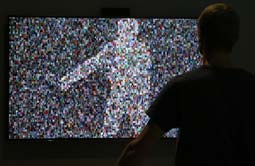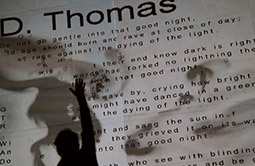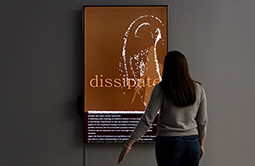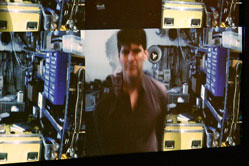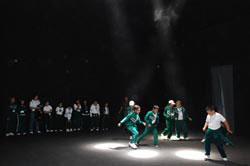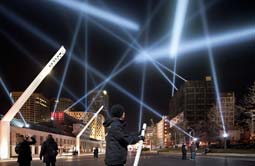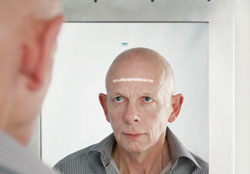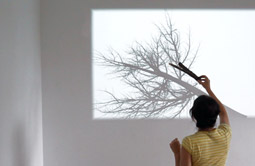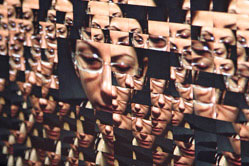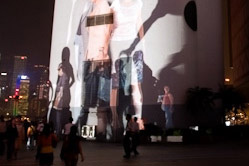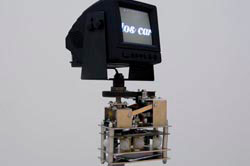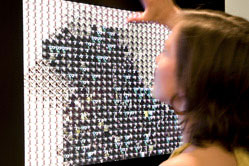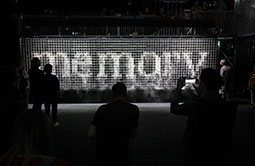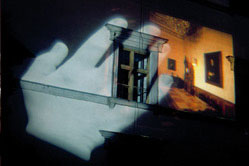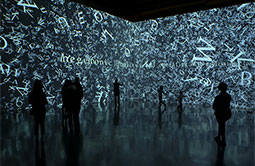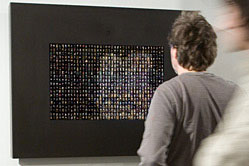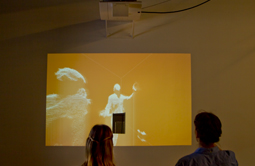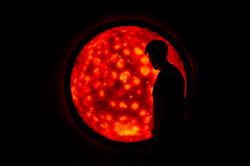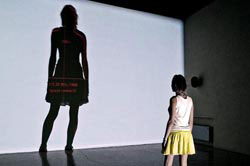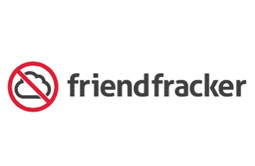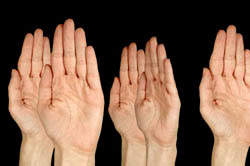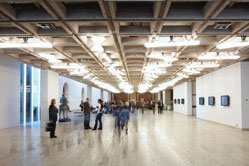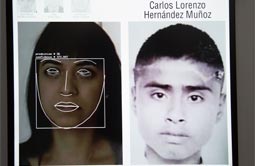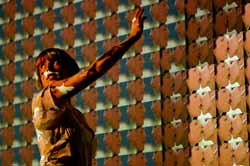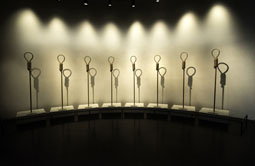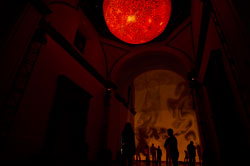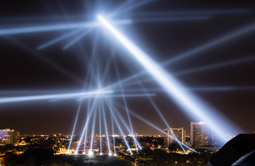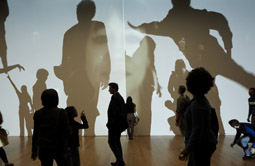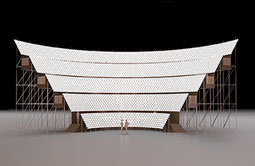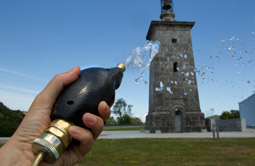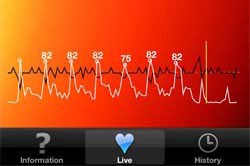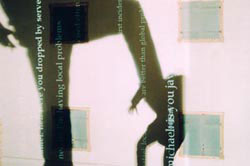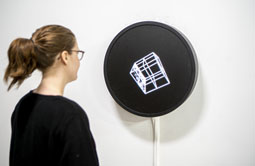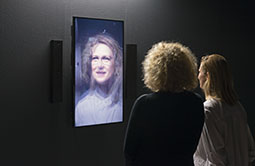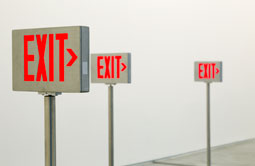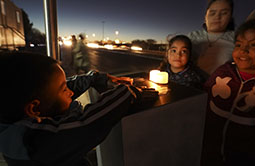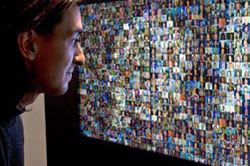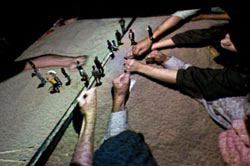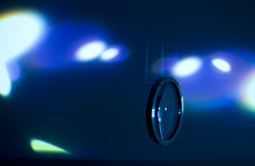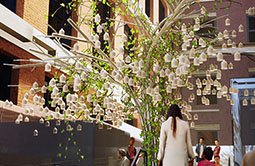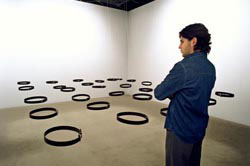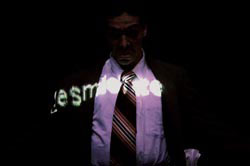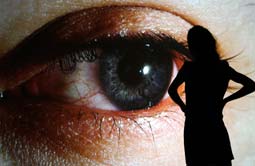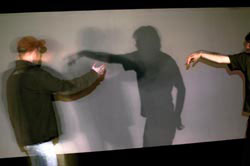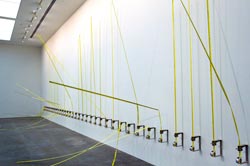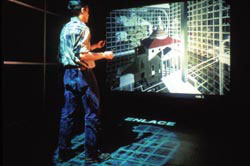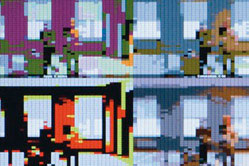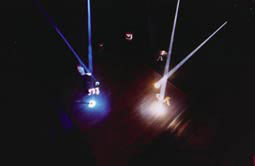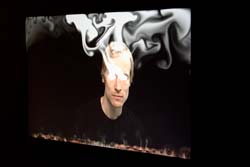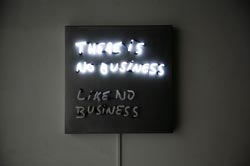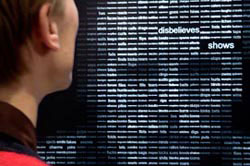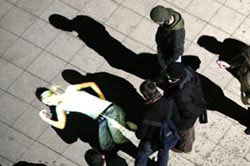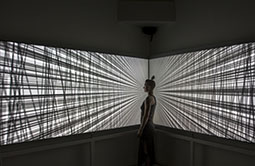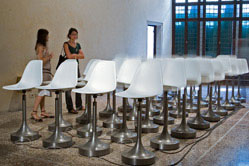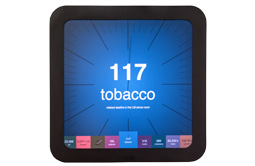1984x1984
Shadow Box 10, 2014
"1984x1984" (Shadow Box 10) is the tenth piece in Lozano-Hemmer’s Shadow Box series of interactive displays with a built-in computerized tracking system. The piece shows a grid of thousands of random numbers extracted from addresses photographed by Google Street View. Scanned by Google from the front doors of buildings around the world, the numbers have an immense variety of fonts, colours, textures, and styles. As a viewer walks in front of the piece, their silhouette is represented within the display, and within its form, all the numbers count down to show the number 1984 repeated throughout. The piece was made as a homage to George Orwell’s eponymous dystopian novel, 30 years after his predicted date for the collapse of privacy.
View details.
View details.
Airborne Newscasts
Relational Architecture 20, 2013
"Airborne Newscasts" (Relational Architecture 20) is an interactive installation originally commissioned by the Chrysler Museum of Art to transform Norfolk, Virginia’s public space into a poetic shadow play. By blocking the light of two projectors, participants cast their shadows onto a 900-square-metre wall, and these shadows are tracked by computerized surveillance systems. Out of the shadows emanate billowing smoke which is mapped onto the wall, slowly accumulating within it. Turbulent clouds of live newscasts evaporate from the “heat” of the tracked bodies.
View details.
View details.
Airborne Series
Shadow Box 11, 2015
“Airborne Series” (Shadow Box 11) is a set of interactive installations designed to animate literary, scientific and philosophical texts on the subjects of entropy, complexity, chance and non-linear dynamics. As a viewer stands in front of the work a sensor creates a "heat map" of his or her body and evaporates letters of the text that scroll on screen and which become "airborne", generating turbulent movements. As the participant moves away the letters cool down and precipitate. The interaction fills the screen slowly, showing tens of thousands of letters, at which point the text fades out, and begins to scroll again from the beginning. Among the texts animated are "New Experiments with the Vacuum" by Blaise Pascal, "Thermodynamics of Irreversible Processes" by Ilya Prigogine, "Ars Magna" by Ramon Llull and "The Labyrinth of Fortune" by Juan de Mena.
View details.
View details.
Alpha Blend
Shadow Box 7, 2008
"Alpha Blend" (Shadow Box 7) is an interactive display with a built-in computerized tracking system that show the viewer's presence, revealing and blending pictures of people who have previously looked at the work. A game of "reverse puppetry" ensues, where a portrait from the past is animated by a live presence, in a similar perceptual mechanism than the one used in Lozano-Hemmer's public art installation "Body Movies" (2001).
View details.
View details.
Apostasis
2008
An interactive installation featuring powerful robotic searchlights that create static columns of light in a dark room. When someone tries to walk into a light beam, a computer automatically moves the searchlight so that the beam is pointed somewhere else on the room. A video tracking system observes the room and makes sure that the lights are always illuminating empty spaces where there is no one. People may continually attempt to enter the spotlight but the system will adapt to ensure this can never be achieved.
View details.
View details.
Articulated Intersect
Relational Architecture 18, 2011
"Articulated Intersect" (Relational Architecture 18) is a large-scale installation that produces an interactive canopy of light that can be modified by the public using six large lever-controllers that protrude from the ground. As a participant points one of these levers three powerful robotic searchlights automatically intersect in the sky to create an apex at that location. The participant may direct the apex anywhere over the city in real-time, creating an animated tetrahedron inspired by the work of Richard Buckminster Fuller.
View details.
View details.
Autopoiesis
2010
When people look at themselves in this small mirror they see the word "Autopoiesis" projected on their forehead. The concept of self-creation described by Chilean biologists Maturana and Varela is an inspiration for all art that depends on participation to exist.
View details.
View details.
Bifurcation
Shadow Object 2, 2012
“ Bifurcation” (Shadow Object 2) is small Y-shaped branch, similar to a divining rod, which is suspended from a thread and moves with the air flow and with a small motor. Projected on the wall behind the branch is its shadow, only you can see the entire tree from where the branch came. The branch and the tree shadow are always oriented in the same way.
View details.
View details.
Blow Up
Shadow Box 4, 2007
"Blow-up" (Shadow Box 4) is an interactive piece designed to fragment a surveillance camera view into 2400 virtual cameras that zoom into the exhibition space in a fluid and autonomous motion. Inspired by 20th-century Italian filmmaker Michelangelo Antonioni, the piece is intended as a an exercise to underline the construction of presence through a simulated, live compound eye.
View details.
View details.
Body Movies
Relational Architecture 6, 2001
"Body Movies" transforms public space with interactive projections measuring between 400 and 1,800 square metres. Thousands of photographic portraits, previously taken on the streets of the host city, are shown using robotically controlled projectors. However the portraits only appear inside the projected shadows of the passersby, whose silhouettes can measure between two and twenty-five metres depending on how close or far away they are from the powerful light sources positioned on the ground.
View details.
View details.
Cardinal Directions
Subsculpture 11, 2010
"Cardinal Directions", is a kinetic sculpture which consists of a surveillance monitor that displays an extract of Vicente Huidobro´s poem "Altazor" (1919-1931). Refering to the geography of his native Chile, Huidobro wrote "The four cardinal directions are three: North and South". When a presence is detected by infrared sensors, the monitor starts to rotate. As the poem is "geolocated" it always aligns itself to the cardinal points, and the public must walk around the piece in order to read it, like a kind of periscope.
View details.
View details.
Close-up
Shadow Box 3, 2006
"Close-up", the third piece of the ShadowBox series, is an interactive piece in which a participant's silhouette reveals hundreds of tiny videos of other people who have previously looked at the work. When a viewer approaches the piece, the system automatically starts recording and makes a video of him or her. Simultaneously, inside the viewer's silhouette, videos are triggered, showing up to 800 recent recordings. This piece presents a schizoid experience where one’s presence triggers a massive array of surveillance videos.
View details.
View details.
Cloud Display
2019
“Cloud Display” is a vertical water fountain consisting of 1,600 ultrasonic atomizers, controlled by a machine-learning voice recognition system. When a participant speaks into an intercom, the piece writes any words or sentences spoken using wisps of pure water vapour. The project can work in most languages, and recognizes different accents.
View details.
View details.
Displaced Emperors
Relational Architecture 2, 1997
"Displaced Emperors" (Relational Architecture 2) was an interactive installation that used an "architact" —architecture meets haptics— interface to transform the facade of the Habsburg Castle in Linz, Austria. Wireless 3D sensors calculated where participants pointed to on the façade and a large animated projection of a hand was projected at that location. As people on the street "caressed" the building, they could reveal the interiors of the Habsburg residence in Mexico City, Castillo de Chapultepec.
View details.
View details.
Encode/Decode
2020
"Encode/Decode," a generative interactive typographical environment made from the critical essay of Jamaican-British cultural studies scholar Stuart Hall (1932-2014) in which he proposes an encoding/decoding model of communication.
View details.
View details.
Eye Contact
Shadow Box 1, 2006
"Eye Contact" (Shadow Box 1) is the first piece of the Shadow Box series of interactive displays with a built-in computerized tracking system. This piece shows eight hundred simultaneous videos of people lying down, resting. As soon as a public member is detected, his or her presence triggers the miniature video portraits to wake up: hundreds of people simultaneously turn to look at the visitor directly, creating an uncanny experience that questions who is the observer and who is the observed.
View details.
View details.
First Surface
Shadow Object 3, 2012
“First Surface” (Shadow Object 3) is an artwork consisting of two front surface mirrors that are suspended from a thread and move with the air flow and with a small motor. Projected on the wall behind the mirrors is a real-time virtual representation of the public as seen from the perspective of the mirrors. The public is represented as patterned 3D silhouettes anchored in a reference prism that rotates with the mirrors. The piece is an attempt to construct an artificial perspective on the reflected subject.
View details.
View details.
Flatsun
2011
“Flatsun” is a circular display that simulates the turbulence at the surface of the Sun using mathematical equations. The piece reacts to the presence of the public by varying the speed and type of animation displayed. If no one is in front of the piece the turbulence slows down and eventually turns off. As the built-in camera detects people, more solar flares are generated and the fake Sun shows more perturbation and activity. At 140 cm diameter, “Flatsun” is exactly a billion times smaller than the real Sun.
View details.
View details.
Frequency and Volume
Relational Architecture 9, 2003
"Frequency and Volume" (Relational Architecture 9) enables participants to tune into and listen to different radio frequencies by using their own bodies. A computerized tracking system detects participants' shadows, which are projected on a wall of the exhibition space. The shadows scan radio waves with their presence and position, while their size controls the volume of the signal. The piece can tune into any frequency between 150 kHz and 1.5 GHz, including air traffic control, FM, AM, short wave, cellular, CB, satellite, wireless telecommunication systems and radio navigation. Up to forty-eight frequencies can be tuned simultaneously and the resulting sound environment forms a composition controlled by people's movements.
View details.
View details.
Friendfracker
2013
“Friendfracker” is a service that automatically deletes a set of friends from your Facebook account. Upon authenticating your data on the website, the service deletes 1 to 10 friends at random. The project was developed with Harper Reed for Rhizome's 7 on 7 conference.
View details.
View details.
Glories of Accounting
Subsculpture 5, 2005
"Glories of Accounting" (Subsculpture 5) is an interactive installation with a surveillance system that detects the position of the public in the exhibition room. When someone walks into the room, large hands appear on the screen automatically. The hands rotate along their forearm axis, following the visitor with the open palms always facing them. As more viewers enter the room, more hands appear, each one following a member of the public.
View details.
View details.
Homographies
Subsculpture 7, 2006
"Homographies" (Subsculpture 7) is a large-scale interactive installation featuring a turbulent light array that responds to the movement of the public using a surveillance tracking system. The installation consists of white fluorescent light tubes hung from robotic fixtures on the ceiling of the exhibition space, equally spaced. Each light tube rotates slowly using a computerized stepper motor and create labyrinthine patterns of light that make "paths" or "corridors" between people. All lights are always on and typically constitute the only lighting in the exhibition hall, except for the natural light that spills into the space.
View details.
View details.
Level of Confidence
2015
"Level of Confidence" is a face-recognition camera that has been trained with the faces of the 43 disappeared students from Ayotzinapa school in Iguala, Mexico. As you stand in front of the camera, the system uses algorithms to find which student's facial features look most like yours and gives a "level of confidence" on how accurate the match is, in percent. The piece will always fail to make a positive match, as we know that the students were likely murdered, but the commemorative side of the project is the relentless search for them and their overlap with the public's own facial features. The project software is available for free download so that any university, cultural centre, gallery or institution can set-up the piece. In addition, if the project is acquired by collectors, all proceeds will go to the affected community, in the form of scholarships for example.
View details.
View details.
Make Out
Shadow Box 8, 2008
"Make Out" (Shadow Box 8) is an interactive piece showing thousands of internet videos of couples looking at each other. As soon as a participant stands in front of the display his or her silhouette is shown and all the couples within it begin to kiss. The massive array of make-out sessions continues for as long as someone is in front of the work—as he or she moves away all the kissing ends.
View details.
View details.
Metrónomos
2018
“Metrónomos” is a kinetic installation consisting of eight inverted nooses, which move slightly according to the rhythm of various global statistics on human rights violations. Commissioned for Mexico’s Memory and Tolerance Museum, the sculptures are presented on pedestals, arranged in a semi-circle. The frequency in which each noose, or metronome, sways depends on the statistic that each one represents: the number of forced displacements or deportations, acts of torture, cruelty and sexual violence, crimes against the environment, among others. Each noose contains the heartbreaking rhythm of a different scale, in order to materialize, symbolically, the frequency in which human rights are violated. Together, they create a chorus of sculptures activated by statistical data.
View details.
View details.
Nave Solar
2011
“Nave Solar” is an interactive installation featuring a fake Sun that is activated by the pendular motion of the public as they hang from a rope and swing along the nave of a 16th Century catholic inquisition church. Using tracking systems, the installation detects the motion of participants and generates smoke that accumulates on the ceiling of the apse as well as activates the Sun's flares, surface turbulence and sun spots.
View details.
View details.
Open Air
Relational Architecture 19, 2012
“Open Air” (Relational Architecture 19) was an interactive artwork that allowed participants’ voices to transform the sky over Philadelphia. Using a website or a free iPhone app participants could record a voice message and listen to and rate other entries. The messages were played-back over the Benjamin Franklin Parkway using 24 powerful robotic searchlights that reacted, both in brightness and position, to the voice’s frequency and volume as well as to the phone's GPS location.
View details.
View details.
People on People
2010
“People on People” is an installation designed to displace the public’s image in real-time, creating a platform for embodiment and interpenetration. The piece consists of floor-mounted projectors that cast the shadow of the public onto a wall and another set of hanging projectors which project images inside the shadows.
View details.
View details.
Population Theatre
2016
"Population Theatre" is a scalable data-visualization theatre consisting of 7.5 billion individual computer-controlled points of light. The purpose of the piece is to create an experience that offers a one-to-one relationship between the world’s population and its data: every person is represented by a single point of light. "Population Theatre" is a platform for making data tangible, a direct representation of demographic data, and as such it can be used to create "data-dramatizations" that may help the public visualize data on political economy, cultural studies, sociology, anthropology, psychology, history, communications and other fields. People may stand on the stage and watch data performances, but they are also encouraged to walk along the corridors amongst the "rows" of monitors, physically "zooming-in" to see individual pixels, subverting the panoptic view and looking back at the public on the stage.
View details.
View details.
Pulse Drip
2012
“Pulse Drip” is an interactive installation originally developed for Urdaibai Art 2012 in which the public can water the lawn at the Torre de Madariaga using a water hose with a heart rate sensor built-in.
View details.
View details.
Pulse Phone
2009
“Pulse Phone” is an application that measures your heart rate by using the iPhone's built-in camera and flash. The application detects small variations in the opacity of your finger as blood flows through it and calculates your pulse in beats per minute using this information. The app visualizes the data graphically and can store it for later reference.
View details.
View details.
Re:Positioning Fear
Relational Architecture 3, 1997
"Re:Positioning Fear" (Relational Architecture 3) was a large-scale installation on the Landeszeughaus military arsenal with a "teleabsence" interface of projected shadows of passers-by. Using tracking systems, the shadows were automatically focused and generated sounds. A real-time IRC discussion about the transformation of the concept of "fear" was projected inside the shadows; the chat involved 30 artists and theorists from 17 countries.
View details.
View details.
Recurrent Rayuela
Text Stream 6, 2020
"Recurrent Rayuela" (Text Stream 6) is a generative artwork made with the 155 chapters of the experimental novel "Rayuela" (Hopscotch) published in 1963 by Argentine writer Julio Cortázar. The piece consists of a black circular screen that shows a cube with thousands of letters from the book in a fluid, animated pool. When the screen is manually rotated by a visitor, the cube tumbles around and the letters become turbulent; after a few seconds, random excerpts from the novel emerge on screen from the turbulence. As soon as the rotation ends the excerpts disappear and the pool of letters stabilizes again.
View details.
View details.
Redundant Assembly
2015
In "Redundant Assembly," an arrangement of several cameras composes a live-portrait of the visitor from six perspectives simultaneously, aligned using face detection. The resulting image is uncanny, detached from the laws of symmetry and the depth perception of binocular vision. If several visitors are standing in front of the work, a composite portrait of their different facial features develops in real time, creating a mongrel "selfie".
View details.
View details.
Reference Flow
2009
"Reference Flow" is an interactive installation where a number of illuminated EXIT signs, supported by motorized stanchions, rotate automatically as people walk past them so that they always signal escape routes to the left. If several people stroll through the signs they get disoriented as they try their best to confront each person with his or her left.
View details.
View details.
Remote Pulse
2019
“Remote Pulse” is an interactive installation consisting of two identical pulse-sensing stations that are interconnected over the internet. When a person places their hands on one station automatically the person on the other station feels their pulse, as the plates vibrate in sync with the heartbeat of the remote person, and vice versa. The piece was originally presented as part of Lozano-Hemmer’s “Border Tuner” installation across the US-Mexico border.
View details.
View details.
Reporters With Borders
Shadow Box 6, 2007
"Reporters With Borders" (Shadow Box 6) is a high-resolution interactive display that simultaneously shows 864 video clips of news anchors taken from TV broadcasts in the United States and Mexico. As the viewer stands in front of the piece his or her silhouette is shown on the display and within it reporters begin to talk. Every 5 minutes the piece switches the video clips - from a database of 1600 - and classifies them along gender, race and country, so that for instance on the left there are only American reporters and on the right only Mexicans.
View details.
View details.
Sandbox
Relational Architecture 17, 2010
“Sandbox” (Relational Architecture 17) is a large-scale interactive installation created originally for Glow Santa Monica. The piece consists of two small sandboxes where one can see tiny projections of people who are at the beach. As participants reach out to touch these small ghosts, a camera detects their hands and relays them live to two of the world's brightest projectors, which hang from a boom lift and which project the hands over 8,000 square feet of beach. In this way people share three scales: the tiny sandbox images, the real human scale and the monstrous scale of special effects.
View details.
View details.
Semioptics for Spinoza
Shadow Object 4, 2012
“Semioptics for Spinoza” (Shadow Object 4) is a plano-convex lens is suspended from a thread and moves with the airflow and with a small motor. Projected on the wall behind the lens is a set of artificial lens flares generated by equations that take into account the orientation of the lens in relation to the viewing public. The project generates fake light beams that go through the real lens: the lens then diffracts and scatters the fake light creating light source aberrations, directional haze and chromatic distortion.
View details.
View details.
Speaking Willow
2020
“Speaking Willow” is a sound sculpture in the shape of a weeping willow tree, between 16 and 20 feet high, which adorns the entrance of the Planet Word Museum. The tree sculpture is fabricated in aluminum and is hollow, except the trunk and branches carry inside data cables that emerge from the structure and hang vertically, slowly swaying with the wind. The tree is covered by living vine, Ivy or other evergreen climbing plants that warm-up the design.
View details.
View details.
Standards and Double Standards
Subsculpture 3, 2004
"Standards and Double Standards" (Subsculpture 3) is an interactive installation that consists of 10 to 100 fastened belts that are suspended at waist height from stepper motors on the ceiling of the exhibition room. Controlled by a computerized tracking system, the belts rotate automatically to follow the public, turning their buckles slowly to face passers-by. When several people are in the room their presence affects the entire group of belts, creating chaotic patterns of interference. Non-linear behaviours emerge such as turbulence, eddies and relatively quiet regions.
View details.
View details.
Subtitled Public
2005
"Subtitled Public" consists of an empty exhibition space where visitors are detected by a computerised surveillance system. When people enter the space, the system generates a subtitle for each person and projects it onto him or her: the subtitle is chosen at random from a list of all the verbs conjugated in the third person. The only way of getting rid of a subtitle is to touch another person, which leads to the two subtitles being exchanged.
View details.
View details.
Surface Tension
1992
"Surface Tension" is an interactive installation where an image of a giant human eye follows the observer with orwellian precision.This work was inspired by a reading of Georges Bataille's text The Solar Anus during the first Gulf War: first wide-spread deployment of camera-guided "intelligent bombs". Present-day computerised surveillance techniques employed by the Department of Homeland Security in the United States through the Patriot Act, provide a new and distressing backdrop for this piece.
View details.
View details.
Sustained Coincidence
Subsculpture 8, 2007
"Sustained Coincidence" (Subsculpture 8) is an interactive installation activated by the spatial relationships of visitors within a gallery. The piece consists of a series of incandescent lightbulbs that light up in reaction to the participants’ positions, in such a way that the shadows cast on the opposing wall are always overlapping. The piece is inspired by the phantasmagorias on the one hand and surveillance and digital analysis on the other.
View details.
View details.
Tape Recorders
Subsculpture 14, 2011
In “Tape Recorders” (Subsculpture 14), rows of motorised measuring tapes record the amount of time that visitors stay in the installation. As a computerised tracking system detects the presence of a person, the closest measuring tape starts to project upwards. When the tape reaches around 3 meters high it crashes and recoils back. Each hour, the system prints the total number of minutes spent by the sum of all visitors.
View details.
View details.
The Able Skin
1997
"The Able Skin" is a media structure designed by architect Emilio López-Galiacho to hide any emblematic building that is not allowed to have a natural death, that is kept alive artificially through restoration, citation and simulation. A virtual reality installation allows participants to tour the first Able Skin, which covers Palladios Villa Rotonda. The participant's motion controls the point of view in the projected environments on the wall and the floor.
View details.
View details.
The Company of Colours
Shadow Box 9, 2009
"The Company of Colours" (Shadow Box 9) is the ninth piece in the Shadow Box series of interactive displays with a built-in computerized tracking system. This piece shows the live camera view constructed out of a palette of named colour swatches that can be rendered by computers. Every few minutes the piece automatically switches to show the live view made with a variety of culturally-significant colour palettes from computer and video game history, including the four shades of green of the original Nintendo Gameboy, the eight colours of teletext, and the 16 colours of the Commodore 64, the Apple II and the ZX Spectrum.
View details.
View details.
The Trace
1995
"The Trace" is a telepresence installation that invites two participants in remote sites to share the same telematic space. The piece consists of light vectors, sounds and graphics that respond to the movement of the participants. Two interactive stations are needed for the piece; these are interconnected with a normal ISDN digital line so they can be in the same exhibition hall, on either side of a city or in different cities.
View details.
View details.
The Year's Midnight
2011
"The Year's Midnight" is an interactive installation that shows the viewers' image on screen, unprocessed, except for plumes of white or black smoke that emanate from their eye sockets until the whole display is filled with a dense smog. Live and recorded eyeballs extracted from the video accumulate on the bottom of the display, similar to traditional representations of St. Lucy. The project's name is the beginning of John Donne's "A Nocturnal Upon St. Lucy's Day, Being the Shortest Day", a mournful poem which inspires this work.
View details.
View details.
There Is No Business Like No Business
2009
“There is No Business Like No Business” is a blinking neon sign, designed during the recession as a cruel beacon of optimism. The blinking speed is directly proportional to the trading volume of any commodity index chosen by the collector or curator, say NASDAQ or Apple or FTSE100. In a slow day, or when the market is closed, the lines of illuminated text will only switch every 8 seconds, while on the busiest trading day they may blink every 2 seconds.
View details.
View details.
Third Person
Shadow Box 2, 2006
"Third Person" (Shadow Box 2) is the second piece of the ShadowBox series of interactive displays with a built-in computerized tracking system. This piece shows the viewer's shadow revealing hundreds of tiny words that are in fact all the verbs of the dictionary conjugated in the third person. The portrait of the viewer is drawn in real time by active words, which appear automatically to fill his or her silhouette. The collector may choose to display the words in English, Spanish or French, or a combination of the three languages.
View details.
View details.
Under Scan
Relational Architecture 11, 2005
"Under Scan" (Relational Architecture 11) is a public art installation based on self-representation. Thousands of "video-portraits" taken in Derby, Leicester, Lincoln, Northampton and Nottingham are projected onto the ground; at first, the portraits are not visible because the space is flooded by white light coming from a high-powered projector. As people walk around the area, their shadows are cast on the ground, revealing the video-portraits in short sequences.
View details.
View details.
Vanishing Points
2018
“Vanishing Points” is a grid-generator software that deforms graphics in real time while taking into consideration the 3D position and orientation of onlookers. Visitors’ heads are tracked, recorded and mapped onto screens, which only appear coherent at particular angles. When two participants enter the interactive area, two vanishing points are created matching their perspective, and when they get physically close, the two grids match and blend into one another. When no one is participating the system shows the vanishing points for the past 12 to 16 viewers.
View details.
View details.
Wavefunction
Subsculpture 9, 2007
"Wavefunction" (Subsculpture 9) is a kinetic sculpture comprised of fifty to one hundred Charles and Ray Eames moulded chairs (designed in 1948) and placed in a regular array of rows, facing the entrance to the exhibition space. When someone approaches the work, a computerised surveillance system detects their presence and the closest chairs automatically begin to lift off the ground, creating the crest of a wave that then spreads over the whole room.
View details.
View details.
Zero Noon
2013
"Zero Noon" is a digital clock that shows the current time according to eccentric metrics: it uses hundreds of different internet-refreshed statistics. The clock's reference systems are all synchronized so that precisely at noon they all zero and start over. The public may change the statistics by manually scrolling through the list using small push-buttons under the built-in display. The metrics come from government data, Harper’s Magazine, financial institutions, NGOs, academic studies and other trusted sources.
View details.
View details.
